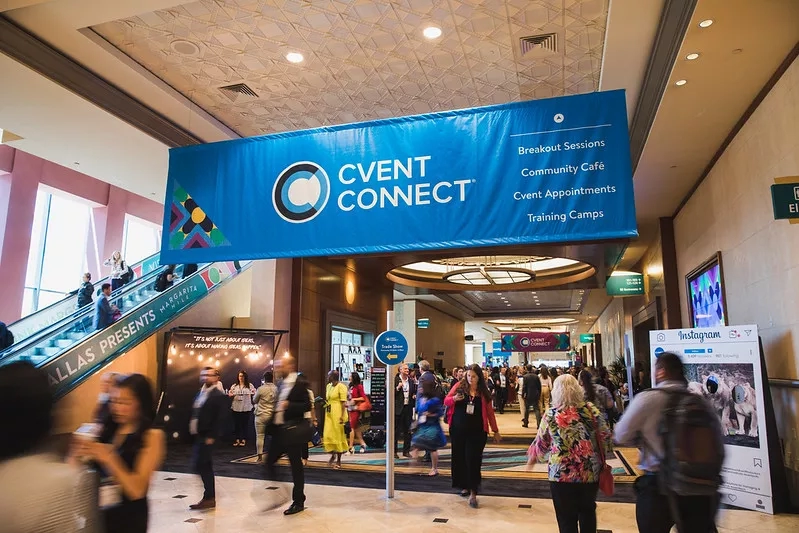Conferences are flagship events that form the foundation of your business growth strategy. They are a critical vehicle to drive modern communication – be it for internal events like sales meetings, board retreats, training seminars, or to reach out to key stakeholders through product launches, press briefings, and annual general meetings. Whether you want to increase revenue, generate leads, boost sales, or train employees, conferences provide crucial opportunities to get your message across to the right audience.
As meetings and conferences become increasingly important to drive your business strategy, so does the need for conference management. Before we dive into this comprehensive guide to conference management, here is a lowdown of what all we will cover:
Contents:
State of the Group Business Industry
The global group business (meetings, events, conferences, and exhibitions) industry is projected to expand at a CAGR of 11.6% from 2023 to 2032, reaching around GBP $2,309.4 billion by 2032. Growth will be primarily driven by a surge in international business travelers, government initiatives to develop the group business sector, and the shift in trends toward creating more tailor-made, immersive experiences using modern event planning software and virtual and augmented reality. Region-wise, Europe has dominated the global group business industry, accounting for 41% of the global group business industry share, and the Middle East is anticipated to witness the highest growth rate from 2023 to 2032 with a CAGR of 18.0%.
With more meetings and conferences being planned, the demand for efficient conference management is likely to increase even more. But to understand what conference management is all about, let’s first define what conferences are and the different types of conferences that happen in the industry.
What Is a Conference?
A conference is a formal gathering of people to discuss a particular subject, which could be academic, business, or political in nature. They are usually paid, closed to the public, and attended by industry experts and keynote speakers who can be celebrities or eminent personalities. The main aim of organizing a conference is to inform, educate, and create more awareness around the topic of discussion.
Types of Conferences
The various conferences organized are:
Seminar
This is an interactive session in which one or two speakers drive the conversation with the audience. A seminar is informative and educational in nature and aims to impart some skills or knowledge to the audience e.g. digital marketing skills, real estate advice, tips on personal finance and investment, etc.
Workshop
Workshops are less formal and involve a lot of attendee participation. Compared to seminars, they are more geared towards imparting new skills to the participants under an instructor.
Roundtable
This is a session where energetic discussions and debates are conducted among the participants. There is no lead speaker and the time allotted to every speaker is limited.
Symposium
A symposium is a small conference in which several experts discuss a common subject. It is usually completed within a day.
Virtual Conference
A virtual conference allows all your attendees to connect through breakout rooms, engaging content, and motivating keynote speakers. An easy way to do all of this is to use a virtual conference platform. Moving a conference virtual lowers the barrier to entry, reducing travel and spending restrictions that otherwise may have kept some people from attending.
Webinars
A webinar is a type of virtual event that is hosted online by either one or several experts. The hosts present their knowledge and insight on a specific topic, usually within 30-60 minutes. Webinars have many purposes, like educating, introducing a product, and training employees – whatever your goal is, you’ll need the best tools to accomplish it. Using the right webinar platform is key to hosting a dynamic and engaging session.
Conference vs Events vs Conventions
‘Events’ are an umbrella term used to describe any sort of organized gathering – from corporate meetings and business conferences to even birthdays and weddings. Both conferences and conventions are included under events; however, conventions have a different purpose altogether. They are more informal in nature, have greater participation and interaction than traditional conferences, and cater to specific industries, professions, and fandoms e.g. the London Comic-Con.
Need for Conference Management
With conferences of all sizes and complexities organized on a regular basis, there is a growing need for event planners to become more adept at conference management. From allocating budgets, optimizing resources, and monitoring team members and tasks to ensuring a smooth onsite experience, you need to oversee the successful execution of the entire project from start to finish.
Here is an interesting analogy. Imagine the conference as a single, colorful tapestry that you need to weave using threads of different colors that represent event budgeting, venue sourcing, registration, onsite experiences, post-event feedback, and others. But how do you manage these threads efficiently in order to avoid creating a tangled mess?
Here is where conference management can be of big help. With so many tasks to navigate, calls to make, people to manage, and things to keep track of, the job can become pretty stressful. With a proper conference management plan in place, you can easily achieve your event goals, reduce costs, and boost attendee satisfaction. So, what are the different ways through which conference management can be undertaken?
Types of Conference Management
In-House Processes
If considerable resources and manpower are available within the organization, the conference can be organized in-house.
Joint Partnerships
At times, event planners work alongside agencies or professionals to provide specialized services e.g. website design, survey management, etc.
Third-Party Organizers
Several companies hire third-party organizers to provide an end-to-end conference management solution. These third-party service providers have a solid reputation in the market and use modern conference management software and tools to manage the event from the start to the end.
Conference Management Process
Organizing a successful conference needs meticulous planning. Each step of the conference management process needs to be thought out to the last detail. Here is a brief list of pointers to help you decide how to proceed:
Step #1 – What Are Your Objectives for the Conference?
First and foremost, you need to decide what’s the purpose of your conference. Are you looking to generate more revenue? Create brand awareness? Launch a new product? Increase memberships? Ultimately, the way you organize your conference will be tied to your end goal, so the first step is to sit down, brainstorm, and list your objectives.
Step #2 – Finalizing the Budget
Once the purpose of your conference has been defined, work on the overall budget. What are the major and minor expenses you will incur? Explore different options for sponsorships that are available and then create a bucket list of all the cost items involved, such as:
- Venue
- Personnel
- Accommodation and travel
- Food and beverage
- Speakers
- Entertainment
- A/V equipment
- WiFi
- Marketing and promotion
- Miscellaneous production costs
Once this is done, add around 10-15% more to the overall expenses since there is always the possibility of cost overruns.
Step #3 – Setting Up Operations
This is the step where you set the wheels of conference management in motion. Create a team to plan and execute the conference, assign dedicated tasks, and draft timelines for completion. Get in touch with vendors for hotels and transportation, and finalize the prices beforehand to get the best deals.
Step #4 – Shortlisting Speakers
Speakers are an important part of your conference and a key factor in attracting more participants. Depending on your budget, shortlist the relevant speakers for your conference and get in touch with them to inquire about their availability. Once you have finalized your list, follow up with the speakers by providing them with a handbook that includes the summary of the conference, the goals you seek to achieve, and what information you are looking to disseminate to attendees.
Step #5 – Setting up a Website, Mobile App, and Digital Marketing Campaigns
For any conference, it is essential to have a neat, navigable website that provides details of the event program and allows easy pre-registration of attendees. You will also need to have dedicated digital and social media marketing teams to create more buzz in the digital space by pushing out engaging content. This could be done in-house or you could tie up with agencies offering specialized services. Marketing can end up being a major cost component so make sure you plan smartly.
Step #6 – Prepare Onsite Operations; Review Equipment Details
Schedule onsite operations with your team to do a dry run of the conference at the venue. Is the audio/video equipment working fine? Are the decorations aligned with the theme of the conference? Will there be a technical support team onsite to help the speakers onstage or to handle any emergencies? It takes only one glitch and last-minute snag to turn your conference into a disaster, so make sure you are on top of things!
Using Conference Management Software
Conference management can be a tedious and tiring affair, especially if a lot of manual work is involved. As an event planner, if you’re spending considerable time and resources on tasks such as managing registrations, bookings, payments, paper forms, etc then it is high time you invested in good conference management software.
How do you identify the best conference management software in the market? It’s simple, just go for the one that can automate complex tasks and is aligned with your end-goals i.e. growing your business, retaining customers, saving precious man-hours, and maximizing ROI.
Features of An Ideal Conference Management Software
To power conferences of different shapes and sizes and create world-class events, an ideal conference management software should offer different functionalities such as:
- Registration management: Manage and streamline registrations for your event. Offer personalized paths based on user preferences to maximize the experience.
- Housing management: Book rooms, transportation itineraries, and associated requests through integration with top travel agencies.
- On-site check-in & badging: Quick check-in process, eliminate queues, and easy badge printing and payment options.
- Speaker management: For academic conferences, create a single hub to collate presentation ideas, bios, headshots, and presentations with an efficient call to papers process.
- Lead management: Provide the necessary tools to collect and follow up on leads. If this feature is tied with your CRM system, then you will also have the required data to track ROI and demonstrate the impact of your conference.
- Session attendance tracking: Track attendee movement during the conference using badge scanning or RFID technology. This will also provide you with the data to analyze attendee behavioral patterns and buying signals.
- Social engagement solutions: Increase attendee engagement through social media sharing options.
- Sponsor management: Track sponsors and readily provide access to information and relevant material.
- Mobile event apps: Keep attendees engaged through push notifications, facilitate conference networking, and provide quick lead capture abilities.
Having a proper conference management plan will help you chalk out a solid strategy for your organization’s short-term and long-term goals. However, before even stepping into the complexities of planning a conference, it is important to first understand attendees' expectations, what they are looking for in your event, and what will make them return for more. Gain access to these critical insights with Cvent’s report, Inside the Mind of Event Attendees.







